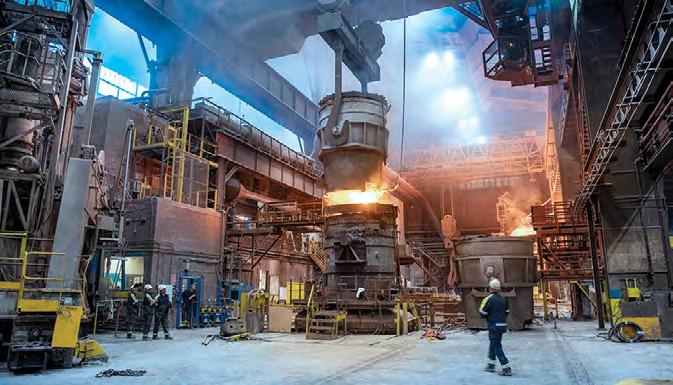
4 minute read
Remote risk assessment methods for the new normal
REMOTE RISK ASSESSMENT METHODS
FOR THE NEW NORMAL
by Nantha Marimuthu, Vice President, Operations Engineering Manager (Asia), FM Global
The approach is based on a mix of old and new tactics.
Mr Nantha Marimuthu
Loss prevention engineers love to roll up their sleeves, put on a hard hat and protective gear, and get their hands dirty assessing a property up close, searching for risks to business operations. Often, they travel long distances to visit plants and facilities for that vital first-hand perspective. This was all before a pandemic halted human movement and altered the economic landscape, resulting in many commercial premises such as factories, warehouses, commercial buildings and power plants, being closed or continuing to function with reduced capacity, while others were put to new uses and stretched to their limits. The explosion at a factory in Tuas, Singapore, earlier this year, that led to a ministerial inquiry, highlights just how prone industrial premises are to disaster. In a disrupted economy, the impact on a business can often be exacerbated, putting pressure on finances and people, so it is crucial that essential checks are carried out to ensure that operational and building integrity are maintained and risks are identified. There have been other incidents in the region too, such as the recent explosion at a plastics factory in Bangkok, Thailand, as well as a fire in a logistics warehouse in China. But in this new normal, where frequency of cross-border travels would still remain low, given how businesses remain cautious about this, how does a loss prevention engineer assess a property or plant from a distance, with the same level of robustness and accuracy? The answer lies in a mixed approach comprising old and new tactics. the real-time data needed for precision risk assessment. Calls, video conferencing and virtual walk-throughs have become a way for engineers to get real-time visual information, in order to advise on loss prevention strategies. Recently, engineers who were unable to visit a large glass bottle manufacturing plant, due to travel restrictions, carried out their risk evaluation remotely. In a span of two months, multiple video conferences were held and hundreds of files were transferred to the loss prevention
Planning on the ground at customer’s factory for a first-time site assessment.
THE APPLICATION OF REMOTE SERVICING TECHNOLOGIES
To solve this dilemma, loss prevention engineers have turned to remote servicing technologies to get

engineers. From these inputs, the engineering team was able to analyse the data and propose a loss prevention solution. When a ‘boots on the ground’ visit was finally completed in late 2020, no new major recommendations had to be made, validating the robustness of the remote analysis. Loss prevention engineers noted that the rigour of the remote process meant they were able to get more and better information right from the start.
Augmented reality for visual assessments
Engineers are also using augmented reality to connect virtually and make a visual assessment of the situation on the ground. Take, for example, a company that was keen to design a complex fire protection solution to meet its risk improvement goals for its high hazard processing facility, but border closures meant it was not possible to get a specialist engineer on site. Working together with the property owner, engineers utilised a newly created ‘Remote Visit’ app to conduct a four-hour virtual tour of the site, enabling collaboration between the client’s engineers and a specialist. The knowledge gained from this virtual visit enabled the engineering team to develop the fire protection solution, involving a combination of drainage, interlocks and deluge water protection.
Tapping unique tools
In some cases, a complex problem calls for something extra. Unable to visit a warehouse site, an engineer toured the facility remotely, using the ‘Remote Visit’ app to analyse rack storage, conduct visual valve inspection and review churn testing records in the fire pump room, in order to enable the verification and completion of a physical exposure control plan. To further support this process, the property owner virtually shared recent aerial drone footage of an area under construction and an updated flood emergency response plan, and photos of recently installed and approved flood abatement equipment. The engineering team continues to conduct regular assessments by remotely attending the testing of the flood abatement equipment using the ‘Remote Visit’ app.
SUMMARY
Indeed, the approach to risk management has adapted over the last year, since the pandemic forced various safe-distancing measures on to us. We have done 15,000 remote servicing reports, compared to only around 30 a year, prior to the pandemic- the highest in recent years. While we predict remote servicing will not permanently replace in-person visits, they have proven to be a robust way to complement boots on the ground and even improve the quality of risk assessments in the interim. The maturity of new technology tools and an adaptive mindset have enabled engineers to continue protecting client facilities throughout the pandemic. This ensures continuity to clients’ need for risk assessment and improvement, as well as management of impairments, regardless of the distance. With restrictions on movements continuing in some countries, this hybrid approach will become the new normal, where engineers can conduct analysis remotely through various tools, with reduced costs and environmental impact, and allow them to be ‘onsite’ almost immediately, supported by increasing use of data and analytics, augmented and virtual reality tools, and satellite imagery.








